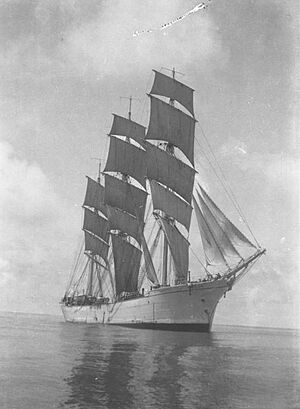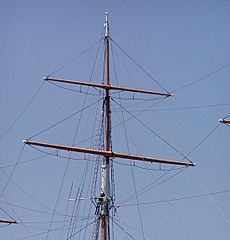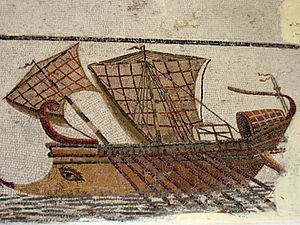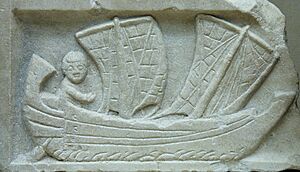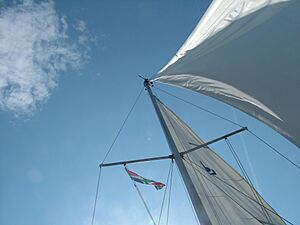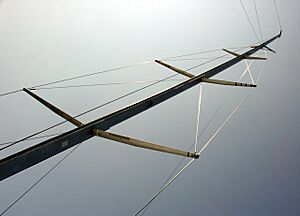Mast (sailing) facts for kids
The mast of a sailing vessel is a tall pole or structure. It stands almost straight up in the middle of a ship or boat. Masts help carry sails, other poles, and derricks (cranes). They also provide height for navigation lights, look-out spots, signal yards, and radio aerials. Large ships often have several masts. Their size and setup depend on the ship's design. Most sailing masts are held in place by strong ropes.
Until the mid-1800s, all ship masts were made of wood. They came from a single tree trunk or several pieces of timber. Often, they used tall conifer trees. From the 1500s, ships became so big they needed masts taller and thicker than any single tree. For these larger ships, masts were built from up to four parts. These parts were called: lower, top, topgallant, and royal masts. To make the lower parts thick enough, they were built from separate wood pieces. This was known as a made mast. Masts made from a single piece of wood were called pole masts. People who specialized in making masts were known as mastmakers.
Parts of a Ship's Mast
For square-sail ships, masts have standard names. They are listed from the front (bow) to the stern (back):
- Sprit topmast: A small mast on the end of the bowsprit (a pole sticking out from the front). This mast was not common after the early 1700s. It is usually not counted when saying a ship has "two" or "three" masts.
- Fore-mast: This mast is closest to the front of the ship. It is always in front of the main-mast. It can be connected to the bowsprit.
- Its parts are: fore-mast lower, fore topmast, fore topgallant mast.
- Main-mast: This is the tallest mast. It is usually found near the center of the ship.
- Its parts are: main-mast lower, main topmast, main topgallant mast, and sometimes a royal mast.
- Mizzen-mast: This is the mast furthest back on the ship. It is usually shorter than the fore-mast.
- Its parts are: mizzen-mast lower, mizzen topmast, mizzen topgallant mast.
Some ships with different sail setups have other mast names. These names are not always the same:
- Bonaventure mizzen: This was a fourth mast on large 16th-century galleons. It usually had a lateen sail and was shorter than the main mizzen.
- Jigger-mast: This is usually the shortest and furthest back mast on ships with more than three masts.
- Its parts are: jigger-mast lower, jigger topmast, jigger topgallant mast.
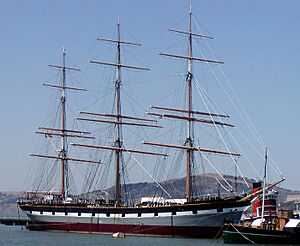
Naming Masts on Sailing Ships
When a ship has two masts, the main mast is usually the one that holds the largest sail.
- On a brig, the front mast is the foremast. The back mast is the mainmast.
- On a two-masted schooner, the back mast is usually the mainmast. This is because it often carries a larger sail.
- However, on a ketch or a yawl, the back mast is much smaller. So, the masts are called (from front to back) mainmast and mizzen. Sometimes, the term "jigger" is used for the back mast on a yawl.
Some two-masted luggers have a fore-mast and a mizzen-mast. They do not have a main-mast. This is because these older ships used to have three masts. But sailors found it easier to remove the middle mast. They then put larger sails on the remaining masts. This gave them more space to work, especially on fishing boats.
On ships with square-rigged sails, each mast holds several horizontal yards. These yards are poles from which the individual sails are attached.
What is a Tabernacle?
Some ships have a tabernacle to help lower their mast. A tabernacle is a special fitting on the deck. It holds the bottom of the mast. It has a pivot point near the top. This allows the mast to be lowered easily. This is useful for transporting the boat or passing under bridges.
The Long History of Masts
Early Mast Designs and Uses
The earliest proof of masts comes from the Ubaid period site of H3 in Kuwait. This dates back to the second half of the sixth millennium BC. There, a clay disc was found. It seems to show a boat made of reeds with two masts.
In the West, ships started using more than one mast. This helped them go faster and sail better. This idea grew in the northern Mediterranean Sea. The first foremast was found on an Etruscan box from Caere, Italy. It dates to the mid-7th century BC. It shows a warship with a furled main sail using a foresail. An Etruscan tomb painting from 475 to 450 BC shows a two-masted merchant ship. It has a large foresail on a slightly tilted foremast. A Corinthian krater from the late 6th century BC shows an artemon (Greek for foresail). It was almost as big as the main sail. However, most Greek longships did not show a foresail until the 4th century BC. In the East, ancient Indian kingdoms like Kalinga used naval sail ships as early as the 2nd century. One of the first records of Indian sail building is a mural. It shows a three-masted ship in the Ajanta caves. This mural dates back to 400–500 CE.
Masts in Ancient Civilizations
The foremast became common on Roman galleys. It was tilted at a 45° angle. It looked more like a bowsprit. The foresail on it was smaller. It seemed to help with steering more than with moving the ship forward. We know foremasts existed from ancient pictures. Also, archaeologists found slots in foremast-feet. These were too close to the prow (front) for a main sail.
The artemon, along with the main sail and topsail, became standard on sea-going ships in Roman times. The largest cargo ships also had a mizzen mast. The first recorded three-masted ships were the giant Syracusia. This was a special ship ordered by King Hiero II of Syracuse. It was designed by the smart person Archimedes around 240 BC. Other Syracusan merchant ships of that time also had three masts. The large Roman grain ships traveling between Alexandria and Rome also had three masts. A mosaic in Ostia (around 200 AD) shows a three-masted cargo ship entering Rome's harbor. Some special boats had even more masts. Theophrastus recorded that the Romans imported wood from Corsica. They used a huge raft with as many as fifty masts and sails.
Throughout ancient times, both the foresail and mizzen remained smaller than the main sail. But they were still large enough to need full running rigging (ropes for controlling sails). In late antiquity, the foremast became less tilted. On some ships, it stood almost straight up.
How Masts Changed in the Middle Ages
By the start of the Early Middle Ages, ship rigging in the Mediterranean changed a lot. The lateen sail, which had been used on smaller Greco-Roman boats, replaced the square rig. The square rig almost disappeared until the 1300s. (It stayed common in northern Europe). The dromon, a Byzantine warship with lateen sails and oars, likely had two masts. It had a larger foremast and one in the middle. Their lengths were about 12 meters and 8 meters. This was a bit smaller than the Sicilian war galleys of that time.
Ships with multiple masts for sailing came back to the Mediterranean Sea in the Late Middle Ages. Ships were getting bigger. So, more masts were needed to control these larger vessels. Unlike in ancient times, the mizzen-mast was added to medieval two-masted ships before the foremast. Pictures from Venice and Barcelona show this happening in the mid-1300s. To balance the sails, the next step was to add a mast in front of the main-mast. This first appeared in a Catalan drawing from 1409. By the early 1400s, the three-masted ship was common. It used square sails and lateen sails. It was steered by a pintle-and-gudgeon rudder. All these advanced ship designs were ready for the great ocean voyages.
The first hollow mast was put on the American sloop Maria in 1845. It was 28 meters (92 feet) long. It was built from wooden strips held together with iron hoops, like a barrel. Other hollow masts were made from two shaped timbers. These were hollowed out and glued together. Almost a century later, a simple box-shaped mast was developed.
Modern Masts and Materials
Even though engine-powered ships replaced sailing ships in the 1800s, people still design and build sailing ships and yachts for fun.
Stronger Materials for Masts
In the 1930s, aluminum masts started being used on large J-class yachts. An aluminum mast has many benefits over a wooden one. It is lighter and thinner than a wooden mast of the same strength. It does not rot. Also, it can be made as one long piece. By the 1960s, aluminum had mostly replaced wood for masts. Aluminum alloys, especially the 6000 series, are commonly used.
More recently, some sailing yachts, especially those built by hobbyists, have started using steel masts. Steel masts are a bit heavier than aluminum ones. However, steel has its own advantages. It is much cheaper. A steel mast of the same strength can also be smaller in diameter than an aluminum mast. This allows for smoother airflow onto the sail.
Special Masts for Racing Yachts
From the mid-1990s, racing yachts began using carbon fibre and other composite materials for masts. These materials offer even better strength for their weight. Carbon fiber masts can also be designed with very precise aerodynamic shapes.
Modern masts form the front edge of a sail's airfoil (like a wing). They often have a teardrop shape when viewed from above. On smaller racing yachts and catamarans, the mast can rotate. This helps it find the best angle for the sail's airfoil. If a mast has a long, thin shape and makes up a big part of the airfoil, it is called a wing-mast. Boats using these masts have a smaller sail area. This makes up for the larger mast area. Many companies make modern masts for sailing yachts of all sizes. Some well-known ones are Hall Spars, Offshore Spars, and Southern Spars.
Masts on Today's Warships
After the age of sail ended, warships still kept masts. At first, they were used as high places for looking out. They also helped observe where cannon shots landed. Later, they held fire control equipment like rangefinders. Today, masts are mounting points for radar and telecommunication antennas. These need to be high up to increase their range. Simple pole, lattice, and tripod masts have been used. Some older Japanese warships even had complex pagoda masts.
-
HMS Invincible with tripod masts (photographed in 1907)
See Also
 In Spanish: Mástil para niños
In Spanish: Mástil para niños
- Dismasting
- Sail-plan


